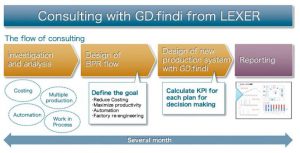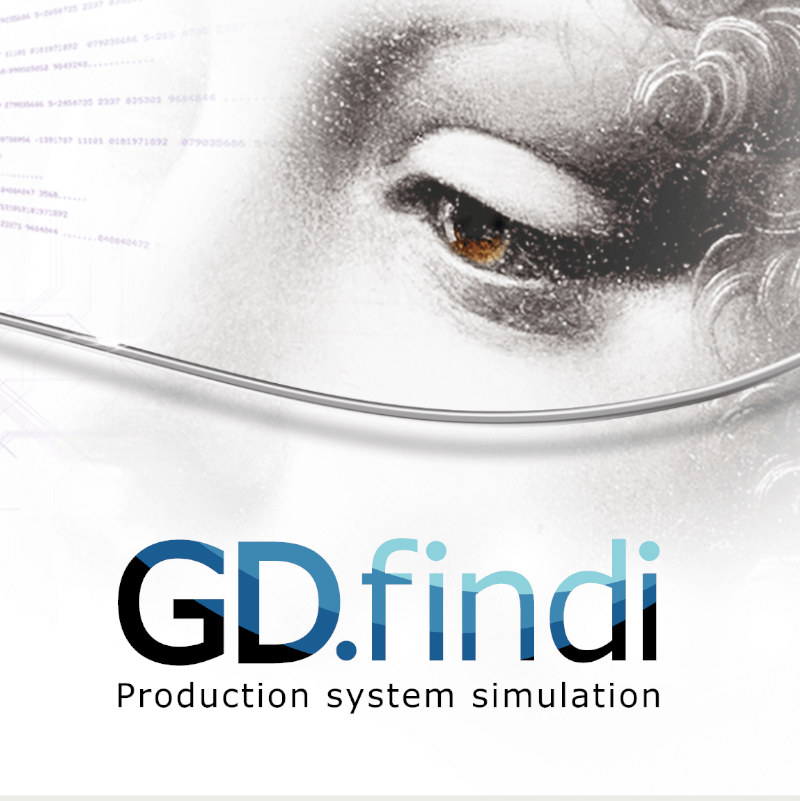Production innovation consulting

Introduction to the production innovation possible with GD.findi
Clients who have used GD.findi have been able to solve various problems that were difficult to respond to with conventional process planning and plant design methods. Here we introduce actual responses for several situations directly faced by manufacturers.

Establishment of production cost targets
Importance of establishing production cost targets and difficulty in finding solutions
Today the trend is towards multi-product production. For example, certain conditions are producing many intermingled derivative products or “long tail products.” Under such conditions, it is difficult to calculate the cost basis. Consequently, products for which the production cost target is unclear are increasing in number. In considering the optimum mode of production for manufactured goods, the establishment of production cost targets is an extremely important factor. Nevertheless, as things now stand you probably don’t have your own calculation methods and calculation standards for them. This kind of planning can make enormous contributions to the finances of a business.
GD.findi helps establish production cost targets
With Lexer Research’s GD.findi production system simulator, when your production plants estimate output, users are able to forecast production lead times for given manufactured goods, the net operating rate for equipment used in the manufacturing process for these items, etc. They can also forecast the time transition for inventory volume between processes.
After setting up plant production lines, an inhouse distribution system and production processes you rely on GD.findi to provide production planning data, you can obtain the kind of information described above. Since the GD.findi simulation results will allow you to grasp the equipment operating rate for each manufactured product, you can then use facility cost distribution models (mean distribution costs, active base costs, etc.) in order to calculate production costs. These in turn can be used to come up with production cost targets.
Carrying out small lot production of many products
Importance of issues related to small lot production of many products and difficulties in finding solutions
It has already been several years since the 2008 Lehman Shock. Nevertheless, many factories have still not been able to break away from the production style of that era that emphasized mass production of a narrow range of products. These kinds of plants find it difficult to respond nimbly to changing demands in a market characterized by short delivery periods, diverse customer needs and small production lots.
What happens when these kinds of factories feel compelled to respond by trying to produce many products in small lots? As the setup time increases, that in turn causes the operating rate to decline and the retention time to increase. The fact is that conventional high productivity simply cannot be maintained.
It is quite evident that in regards to such small lot manufacturing of many different products, there are numerous issues which need to be resolved in order for manufacturers to somehow be able to survive today. Yet, there are no easy solutions to these pressing issues.
Assistance for achieving small lot production of many products
What kinds of ideas are there for achieving the small lot production of many models? From the standpoint of production instructions, instead of lot production in which only a given quantity of the same item is produced, manufacturers can employ the comingled “oneitem manufacturing” instruction method. With this approach individual orders from different customers are filled according to the tempo with which the orders come in.
Furthermore, from the standpoint of production system composition, there are the job shop method under whichthe flow of products or parts is determined by the process, the flow shop method for handling the flow of products on conveyor belts, the Ushaped line method that falls somewhere in between, and so on. These options are related to the skill level of the workers. For example, in order to ensure the efficient flow of small lot orders on a Ushaped line, the workers must be equipped with a versatile skill set.
When considering individual machines, being able to shorten the time required for retooling is a necessary condition for production of many different items in small lots. In order to shorten the changeover time required, it is necessary to reduce the actual time spent on retooling through the development of special jigs and other tools, as well as offline retooling.
Production of many different items in small lots can be achieved through the optimum combination of various ideas. Of course you can freely combine various ideas through trial and error, but that can turn into an extremely complex and formidable job. In order to be able to carry out this complex and formidable job in systematic and speedy fashion, you should take advantage of the power of the production system simulator GD.findi.
Since GD.findi separately defines floor plan and production processes, as well as job shops, flow shops, Unshaped lines and other floor plans, as well as production processes, by simply hypothesizing multiple cases for them, this production system simulator can carry out large volume NtoM trialanderror match ups in a short period of time. Furthermore, since with GD.findi utility is markedly superior as compared to conventional simulators, you the customer can freely combine your own ideas for the testing of hypotheses. Thus, the burden associated with this work is reduced to an astonishing degree as compared to how it used to be. The end result is that you can achieve the best possible production system.
Introduction of Automation Equipment
Importance of the introduction of automation machinery and difficulties in finding solutions
The introduction of automation machinery for use in automation assembly, automation transport, etc., as a strategy for responding to demands to improve productivity, stabilizing product quality or dealing with a shortage of human resources, deserves careful consideration in terms of its effectiveness as an investment. That is because of the high cost of automation devices.
However, quantitatively ascertaining the effects of such a move is by no means an easy task. The reason why is that the degree of contribution to productivity by the automation devices is determined by various factors, including layout, process planning, configuration of the equipment, deployment of the workforce, retooling equipment, production plans, etc. These various factors are interconnected in complex fashion.
By using the GD.findi production system simulator, you can make the right judgments concerning the introduction of automation equipment. In addition, another consideration in the introduction of automation equipment is the maintenance of flexibility in responding to fluctuations in production. Maintenance of flexibility in responding to changes in production volume or changes in product items is critical in the introduction of automation machinery.
GD.findi is the answer to the problem of how to achieve proper tradeoffs between productivity and flexibility.
Support for consideration of the installation of automation machinery
By making use of production system simulations, you can grasp the operating rate for the automation machinery you are seeking to verify. In addition, you can set up various hypothetical conditions for factory operations, and also infer conditions which would result in a decrease in the operating rate. This approach will clarify the points that you need to be careful about when installing the automation equipment.
If in hypothesizing various conditions of factory operation, you can maintain a certain operating rate for the automation equipment you are seeking to verify, you will have gained evidence that automation would indeed contribute to productivity. Moreover, the operating rates you identify by employing GD.findi will enable you to calculate production costs by using various methods, including ABC (activitybased costing) or MFTC (material flow time costing) analysis.
Consequently, by comparing production costs before automation with after automation, you can also verify the effects of the introduction of automation machinery from a financial perspective.
Minimization of Work in Process
The importance of inventory minimization and difficulties in finding solutions
Excess inventories at factories or distribution facilities are harmful in many ways. For example, if capital is tied up in inventory, it can adversely impact financial performance. Furthermore, inventories can make it difficult to identify problems concerning production equipment, employees or in management. That in turn can create problems, including a corporate culture that makes it difficult to identify opportunities for improvement. In addition, inventories can force the extension of lead times, which can alter the situation concerning components, etc. Inventories thus can cause problems with quality control management.
Production that emphasizes minimization of inventories is referred to as the “lean production method.” This production method originated in Japan’s motor vehicle industry. It is supported by an integrated system incorporating various kinds of knowhow accumulated through long experience. However, what about general manufacturers who do not have a track record of actual experience with this approach? Isn’t there some way for them to take steps ahead of time to avoid confusion on the production line and the harmful effects of unnecessary inventories, while honing their awareness of how things can be improved?
The Lexer production system simulator GD.findi is the answer, since with it manufacturers can achieve inventory minimization through “virtual production lines.”
Help in dealing with inventory minimization
Inventories come about for various reasons, including differences in process capabilities, policies for maintaining safety stock, unforeseen accidents and machinery breakdowns, or gaps in the timing of production instructions.
With the production system simulator GD.findi you can virtually materialize or generate all of these scenarios. Moreover, since you can also carry out simulations that continuously alter these factors, it is possible to grasp complex occurrences of these various factors, as well as threshold values and boundary conditions.
As a specific example, let’s look at a case of minimization of inventories among certain processes. Survey results for this factory showed that lot sizes for these processes were large. It was also discovered that for components where there was a bias in the volume used depending on the lot, inventories piled up for a long period prior to the processing. The lot sizes were large for that reason. In this case, we can conceive of several policies designed to curtail inventory volumes.
In cases where the retooling of equipment (changeover) takes a long time, and therefore lot sizes need to be made larger in order to achieve a certain operating rate, manufacturers can adopt suitable policies such as offline set up, upgrading of tooling equipment, etc. If you cannot provide customers with accurate and timely information regarding deliveries, there will no doubt be times when this will result in moving forward the timing of the production schedule, which would be one reason for preprocessing inventory volume accumulation. In such cases, it is probably necessary to introduce an IT system capable of providing notification of the production schedule in timely fashion. In order to be able to judge the suitability of these policies, at the same time that you are considering specific equipment and IT systems, or even before that, it is necessary to assess their likely effects on the production system. If you use the production system simulator GD.findi, then at the time of upgrading or introducing tooling arrangements, you will be able to input conducting wire information and process information. By comparing the new setup with the old one, you will be able to verify the effects.
Moreover, based on the above-mentioned effects resulting from installation of an IT system, you can input the disparities in the production/transportation plans. Here too you can verify the results by comparing the old with the new. Upgrading/introduction of tooling arrangements or the adoption of IT systems in either case will be reflected in the simulation model being used. So it goes without saying that it should be possible to simultaneously verifyimprovement results for both the hardware and software aspects.









